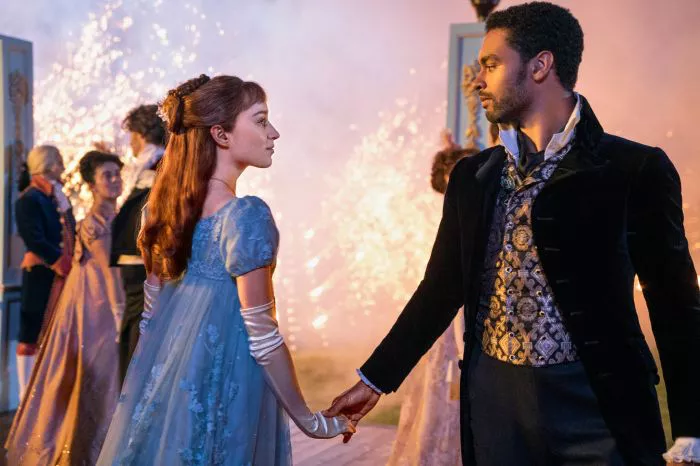“Bridgerton,” the Netflix original series created by Chris Van Dusen and produced by Shonda Rhimes, invites viewers into the dazzling world of Regency-era London, where aristocratic families vie for social status, power, and love. Adapted from the best-selling book series by Julia Quinn, “Bridgerton” captivates audiences with its blend of romance, scandal, and intrigue set against the backdrop of lavish ballrooms, elegant estates, and intricate social rituals. In this review, we’ll explore the many delights of “Bridgerton” and why it has become a must-watch sensation for fans of period dramas and romance alike.
Plot and Characters
At the heart of “Bridgerton” lies the eponymous Bridgerton family, headed by the widowed matriarch, Violet Bridgerton, and her eight vibrant children. The series follows the lives and romantic escapades of the Bridgerton siblings, each with their own distinct personalities, aspirations, and challenges. From the eldest daughter Daphne’s debut into society to the romantic entanglements of her brothers and sisters, “Bridgerton” weaves a rich tapestry of love, desire, and betrayal that keeps viewers on the edge of their seats.
Central to the storyline is the whirlwind romance between Daphne Bridgerton and Simon Basset, the Duke of Hastings. Their fake courtship evolves into a passionate love affair, but their happiness is threatened by secrets, scandals, and societal expectations. Meanwhile, Daphne’s brother Anthony navigates his own romantic entanglements while grappling with his responsibilities as head of the family. As the season unfolds, alliances shift, secrets are revealed, and the mysterious Lady Whistledown’s scandalous society papers add fuel to the fire, culminating in a climactic finale that leaves viewers eagerly awaiting the next chapter.
Themes and Messages
“Bridgerton” explores a wide range of themes and messages that resonate with viewers on a personal and emotional level. At its core, the series is a celebration of love, romance, and the human heart’s capacity for passion and desire. It delves into the complexities of relationships, the pursuit of happiness, and the challenges of navigating societal expectations and norms. Moreover, “Bridgerton” challenges traditional gender roles and power dynamics, highlighting the struggles of women to assert themselves in a patriarchal society.
Through its diverse cast of characters and captivating storylines, “Bridgerton” also addresses broader themes of identity, privilege, and social justice. The series confronts issues of race, class, and inequality, offering a nuanced portrayal of Regency-era society that reflects the complexities of the human experience. From the opulent ballrooms of the aristocracy to the bustling streets of London’s slums, “Bridgerton” paints a vivid picture of a world in flux, where love and ambition collide against a backdrop of tradition and change.
Production Design and Cinematography
One of the most striking aspects of “Bridgerton” is its lavish production design and stunning cinematography, which transport viewers back in time to the glamour and grandeur of Regency-era London. From the opulent costumes and elaborate hairstyles to the majestic estates and bustling streets, every detail is meticulously crafted to immerse viewers in the world of the story. The series’ vibrant color palette, lush cinematography, and evocative score create a sensory feast for the eyes and ears, drawing viewers deeper into the captivating world of “Bridgerton.”
Performances
The success of “Bridgerton” is due in no small part to the exceptional performances of its talented cast, who bring the characters to life with depth, nuance, and authenticity. Phoebe Dynevor shines as the spirited and enchanting Daphne Bridgerton, capturing the character’s journey from innocence to passion with grace and charisma. Opposite her, Regé-Jean Page delivers a mesmerizing performance as the brooding and enigmatic Duke of Hastings, imbuing the character with vulnerability, intensity, and irresistible charm.
Supporting performances from the ensemble cast further elevate the series, with standout performances from Nicola Coughlan as the lovable and spirited Penelope Featherington, Claudia Jessie as the sharp-witted and independent Eloise Bridgerton, and Adjoa Andoh as the regal and formidable Lady Danbury. Each actor brings a unique energy and presence to their role, contributing to the rich tapestry of characters that populate the world of “Bridgerton.”
Conclusion
In conclusion, “Bridgerton” is a sumptuous feast of romance, scandal, and intrigue that captivates viewers with its compelling characters, intricate plotlines, and lush production design. Through its exploration of love, ambition, and societal expectations, the series offers a rich and immersive viewing experience that resonates with audiences of all backgrounds. With its diverse cast, vibrant storytelling, and evocative visuals, “Bridgerton” has become a cultural phenomenon and a must-watch for fans of period dramas and romance alike. As viewers eagerly await the next installment of the series, “Bridgerton” continues to leave an indelible mark on the world of television, proving that love knows no bounds, and scandal is always in fashion.
Related Topics:
Bridgerton: Love, Scandal, and Society in Regency London
Is Queen Charlotte in Bridgerton historically accurate?

